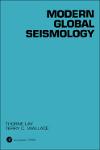




Intended as an introduction to the field, Modern Global Seismology is a complete, self-contained primer on seismology. It features extensive coverage of all related aspects, from observational data through prediction, emphasizing the fundamental theories and physics governing seismic waves--both natural and anthropogenic. Based on thoroughly class-tested material, the text provides a unique perspective on the earths large-scale internal structure and dynamic processes, particularly earthquake sources, and on the application of theory to the dynamic processes of the earths upper skin. Authored by two experts in the field of geophysics. this insightful text is designed for the first-year graduate course in seismology. Exploration seismologists will also find it an invaluable resource on topics such as elastic-wave propagation, seismicinstrumentation, and seismogram analysis useful in interpreting their high-resolution images of structure for oil and mineral resource exploration. Key Features * More than 400 illustrations, many from recent research articles, help readers visualize mathematical relationships * 49 Boxed Features explain advanced topics * Provides readers with the most in-depth presentation of earthquake physics available * Contains incisive treatments of seismic waves, waveform evaluation and modeling, and seismotectonics * Provides quantitative treatment of earthquake source mechanics * Contains numerous examples of modern broadband seismic recordings * Fully covers current seismic instruments and networks * Demonstrates modern waveform inversion methods * Includes extensive references for further reading.Introduction: Historical Development of Global Seismology. The Topics of Global Seismology. Elasticity: Strain. Stress. Equation of Motion. Wave Equations: P and S Waves. Body Waves and Ray Theory:The Eikonal Equation and Ray Geometry. Travel Times in a Layered Earth. Travel-Time Curves in a Continuous Media. Travel Times in a Spherical Earth. Wave Amplitude, Energy, and Geometric Spreading. Partitioning of Seismic Energy at a Boundary. Attenuation and Scattering. Surface Waves and Free Oscillations: Free-Surface Interactions. Rayleigh Waves. Love Waves. Dispersion. Tsunamis. Free Oscillations. Attenuation of Surface Waves and Free Oscillations. Seismometry: Inertial Pendulum Systems. Earth Noise. Electromagnetic Instruments and Early Global Networks. Force-Feedback Instruments and Digital Global Networks. Seismic Arrays and Regional Networks. Seismogram Interpretation: Nomenclature. Travel-Time Curves. Locating Earthquakes. Generalized Inverse. Determination of Earth Structure: Earth Structure Inversions. Earth Structure. Seismic Sources: Faulting Sources. Equivalent Body Forces. Elastostatics. Elastodynamics. The Seismic Moment Tensor. Determination of Faulting Orientation. Earthquake Kinematics and Dynamics: The 1-D Haskell Source. The Source Spectrum. Stress Drop, Particle Velocity, and Rupture Velocity. Magnitude Scales. Seismic Energy and Magnitude. Aftershocks and Fault Area. Scaling and Earthquake Self-Similarity. Earthquake Statistics. Seismic Waveform Modeling: Body Waveform Modeling: The Finite Fault. Surface-Wave Modeling for the Seismic Source. The Source Time Function and Fault Slip. Complex Earthquakes. Very Broadband Seismic Source Models. Seismotectonics: Divergent Boundaries. Transcurrent Boundaries. Convergent Boundaries. Intraplate Earthquakes. The Earthquake Cycle. Earthquake Prediction. Subject Index.
Readership Map
Content Distribution


Intended as an introduction to the field, Modern Global Seismology is a complete, self-contained primer on seismology. It features extensive coverage of all related aspects, from observational data through prediction, emphasizing the fundamental theories and physics governing seismic waves--both natural and anthropogenic. Based on thoroughly class-tested material, the text provides a unique perspective on the earths large-scale internal structure and dynamic processes, particularly earthquake sources, and on the application of theory to the dynamic processes of the earths upper skin. Authored by two experts in the field of geophysics. this insightful text is designed for the first-year graduate course in seismology. Exploration seismologists will also find it an invaluable resource on topics such as elastic-wave propagation, seismicinstrumentation, and seismogram analysis useful in interpreting their high-resolution images of structure for oil and mineral resource exploration. Key Features * More than 400 illustrations, many from recent research articles, help readers visualize mathematical relationships * 49 Boxed Features explain advanced topics * Provides readers with the most in-depth presentation of earthquake physics available * Contains incisive treatments of seismic waves, waveform evaluation and modeling, and seismotectonics * Provides quantitative treatment of earthquake source mechanics * Contains numerous examples of modern broadband seismic recordings * Fully covers current seismic instruments and networks * Demonstrates modern waveform inversion methods * Includes extensive references for further reading.Introduction: Historical Development of Global Seismology. The Topics of Global Seismology. Elasticity: Strain. Stress. Equation of Motion. Wave Equations: P and S Waves. Body Waves and Ray Theory:The Eikonal Equation and Ray Geometry. Travel Times in a Layered Earth. Travel-Time Curves in a Continuous Media. Travel Times in a Spherical Earth. Wave Amplitude, Energy, and Geometric Spreading. Partitioning of Seismic Energy at a Boundary. Attenuation and Scattering. Surface Waves and Free Oscillations: Free-Surface Interactions. Rayleigh Waves. Love Waves. Dispersion. Tsunamis. Free Oscillations. Attenuation of Surface Waves and Free Oscillations. Seismometry: Inertial Pendulum Systems. Earth Noise. Electromagnetic Instruments and Early Global Networks. Force-Feedback Instruments and Digital Global Networks. Seismic Arrays and Regional Networks. Seismogram Interpretation: Nomenclature. Travel-Time Curves. Locating Earthquakes. Generalized Inverse. Determination of Earth Structure: Earth Structure Inversions. Earth Structure. Seismic Sources: Faulting Sources. Equivalent Body Forces. Elastostatics. Elastodynamics. The Seismic Moment Tensor. Determination of Faulting Orientation. Earthquake Kinematics and Dynamics: The 1-D Haskell Source. The Source Spectrum. Stress Drop, Particle Velocity, and Rupture Velocity. Magnitude Scales. Seismic Energy and Magnitude. Aftershocks and Fault Area. Scaling and Earthquake Self-Similarity. Earthquake Statistics. Seismic Waveform Modeling: Body Waveform Modeling: The Finite Fault. Surface-Wave Modeling for the Seismic Source. The Source Time Function and Fault Slip. Complex Earthquakes. Very Broadband Seismic Source Models. Seismotectonics: Divergent Boundaries. Transcurrent Boundaries. Convergent Boundaries. Intraplate Earthquakes. The Earthquake Cycle. Earthquake Prediction. Subject Index.